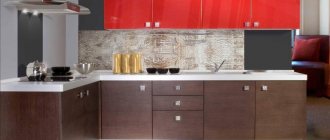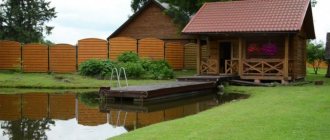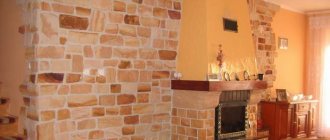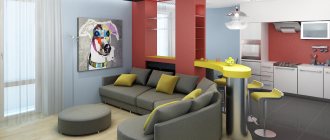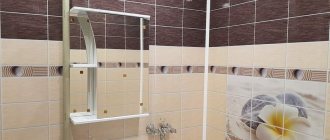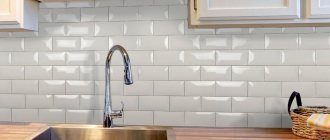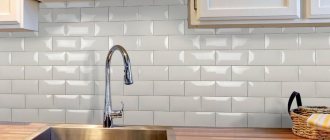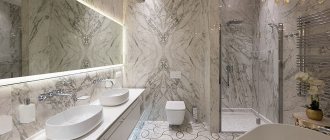Photo: rmnt.mirtesen.ru A bathhouse is an ideal place to relax, where it is so pleasant to escape from work and the bustle of the city. So why not make it as beautiful as possible? Where, if not here, is everything aimed at feeling good and comfortable? The interiors of bathhouses and saunas receive undeservedly little attention, but we are ready to correct this injustice!
Key Features
Plan the interior of the steam room, dressing room and relaxation room together - it’s more convenient, cheaper and easier to immediately calculate the consumption of materials. Refuse parts with sharp edges, avoid unnecessary corners and any other potentially traumatic parts.
Choose light-colored wall paneling because it will make a small, windowless room appear larger and lighter. Instead of decor, use bath accessories and accessories. Completely avoid metal, plastic, artificial materials, slippery surfaces, and bulky furniture.
Content
The interior, made in the Russian style, is a classic.
Beautiful interior inside the bathhouse
In fact, everyone is provided with such familiar attributes as brooms, hats, buckets, gangs. Only by adhering to the integrity of the overall style and competently choosing the necessary accessories can you make your sauna unique and its interior special.
Design depends on the choice of material
Bath finishing materials
It is recommended to use only natural materials in the interior of the sauna, because they are probably non-toxic in case of high humidity and temperature changes. Wood is most often used, and stone and ceramic tiles are used a little less often. Glass, brick and completely unconventional, but very useful salt blocks will do.
Walls
Wood warms up quickly, releases heat slowly and is rich in natural phytoncides. In “dry” areas, you can use coniferous lining with its natural antiseptic effect. But not in the steam room itself, because when heated, the needles release sticky resins.
For a steam room, pay attention to linden, birch, aspen, oak, beech and ash - they are not so sensitive to high humidity. Tiled mosaic looks impressive in the design of a shower room, swimming pool or individual decorative areas. When heated, salt blocks release beneficial minerals.
Wood is used to decorate the steam room without additional processing so that it retains its natural healing properties. For “dry” areas, decorative panels for logs, block houses, planks and any other types of wooden cladding are suitable. To make the coating more durable, it is coated with oil or wax compounds.
Floor
For the floor, be sure to choose collections with a textured anti-slip coating. Linoleum and other artificial materials should not be used. Wood boards are also not suitable, because they are too fire hazardous for a bathhouse, and the more budget-friendly ones also contain formaldehyde.
Ceiling
Wooden cladding with a vapor barrier is also suitable for the ceiling, but it is better to place suspended structures in the dressing room and rest room. Ceiling lining looks beautiful, looks impressive, and ensures a healthy microclimate and air circulation.
Lighting
Use built-in ceiling lights - they are the safest and most practical. Small salt lamps-night lights are suitable for decoration. But it’s better to avoid floor lamps and sconces, because the steam room itself is usually small and every centimeter counts.
Furniture
Furniture with soft, rounded shapes is suitable for saunas and baths. L-shaped benches are also suitable if they go the entire wall so that there are no external corners. This is necessary, first of all, so that if someone suddenly becomes unwell, they do not incur additional injuries.
12 design ideas for a small hallway (photo)
Finishing inside the steam room
Since buildings are made of different materials, owners are interested in whether there is any difference in how to decorate a steam room in a bathhouse, say, from brick or foam concrete. In principle, there are no differences even at the level of constructing an insulating pie, and even more so the finishing does not depend on what the walls of your bathhouse are built from.
However, options do exist.
Interior decoration in a bathhouse made of timber or logs
A beam or log is a material that in itself has excellent decorative qualities, so there is no point in hiding it under the skin, unless your area is in the Arctic cold, that is, if the thickness of the log or beam is enough to keep warm.
In this case, the owner’s main concern will be insulating the joints with inter-crown insulation between logs or beams and sealing (which we will discuss separately). In addition, finishing works include protecting log walls from various misfortunes (fire, water, insects, fungi and bacteria) and revealing the decorative properties of wood - both are done with the help of impregnations.
BUT! In the steam room, protective measures are limited to antiseptic on the lower rims and impregnation for the walls as a whole, which will protect them from water.
A well-sanded log has a beautiful “moire” pattern, which can be made more visible with the help of varnish or impregnation. On our website parilochka.com there is an article that talks about paints and varnishes that are acceptable for processing steam rooms.
Finishing with clapboard in a bathhouse made of aerated concrete, foam concrete, brick, frame
The finishing of a steam room in a bathhouse built from the materials listed in the title will in the vast majority of cases be reduced to clapboard cladding. This is the easiest way to make the interior “wooden”. In addition, lining is a convenient and affordable material, and the difference in profiles gives the owner the freedom to choose according to his tastes.
Baths not built from wood are usually insulated. In this article we will not describe the thermal insulation pie - you can read about it in this article on our website. However, we will spoil it: methods of thermal insulation finishing of a steam room in a bathhouse made of aerated concrete, foam concrete, etc. are the same . And the lining is the final stage of this finishing.
The lining is attached to the counter-lattice. There are several ways to attach it inconspicuously. Previously, this was most often done with finishing nails through a groove, but this is hard work, especially when compared with the modern method of fastening to staples or nails using a pneumatic gun through clamps. As an option, you can attach it to self-tapping screws.
IMPORTANT! Clippers do not replace fastening with nails or staples, they only simplify it. A nice and convenient addition.
Watch the video, which clearly demonstrates the method of fastening the lining using clamps:
Regarding the finishing of the steam room with clapboard, it is worth saying one more thing: there are two mounting options - vertical and horizontal. Accordingly, the counter-lattice should go in a perpendicular direction.
Since we are talking about a humid and hot room, it is worth noting that vertical fastening of the lining is not optimal. Each individual lamella with this arrangement is moistened unevenly, which leads to stress inside the wood. In the future it may crack.
At the same time, horizontal fastening makes the lamellas moisturized more uniformly . The main thing is not to forget when fastening that the groove should be on top, and the tenon should enter it from below. Then water will not flow into the lock.
In addition to the above, the described types of lining installation also have this feature: vertical fastening visually makes the room taller, and horizontal fastening makes the room appear lower.
Interior styles
Modern baths do not have to be monotonous, like a carbon copy. The sauna can also match any interior style if you use a little imagination!
Bathhouse in the old Russian style
In our latitudes, this is the most popular solution for decorating baths and saunas. The Old Russian style resembles a cozy village hut. These are natural logs, rough furniture, embroidery, dried flowers, cozy textiles and an aged stove.
Bathhouse in Scandinavian style
Scandinavian interiors have firmly conquered the market over the past few years, and saunas are no exception. This is a minimum of furniture and decor, contrasts and accents, light wood and free space. Such baths are functional, pragmatic and very attractive in their brevity.
Country style bathhouse
At its core, country is the same rustic style, but with a Western twist. It is dominated by light, smooth wood, beams and beams, ceramics, clay, bright utensils and accessories. Stone and brick are used, and in dry areas leather and forged elements are used.
Bathhouse in ethnic style
Moroccan and oriental motifs, intricate interweaving of textures and exotic patterns are now in fashion. These baths are a little mystical, but very inspiring. Pay special attention to lighting, because romantic twilight sets the mood for eclectic decoration.
Bathhouse in a modern style
Here, natural wood is harmoniously combined with the most modern equipment and technology. For example, a multifunctional shower stall with lighting against the backdrop of absolutely smooth lining. The design is dominated by minimalism, the principle of contrasts and laconic forms.
Some tips
When finishing baths, do not use metal parts inside, even in the form of fasteners or holders. It's very easy to get burned by them.
Shelves and benches can be made stationary or removable. It is correct to place them against a blank wall. There should be a free space of 1.2 meters from the top shelf to the ceiling. This will allow you to sit on it comfortably.
Stationary shelves in the bath
Make shelves of different sizes. The lower one can be narrower, within half a meter, but the upper one should be made one and a half meters wide. This will make it more convenient to use them.
Multi-sized shelves are more convenient to use
When finishing the bathhouse inside, chipboard, plastic, and linoleum should not be used. The presence of painted surfaces is not allowed, even in the waiting room.
To ensure an optimal microclimate inside, take care of heat and do not make window openings too large.
Small window openings will help save heat
Set up dim lighting. This will promote relaxation.
Dim light in the steam room promotes relaxation
Install the sheathing lining vertically. In this case, water will not accumulate in the grooves.
With vertical clapboard cladding, water does not accumulate in the grooves
Don't insulate floors. The water flow must be free, then the covering boards will not rot in one season.
Interior of the dressing room
The dressing room in front of the sauna is the same as the hallway in the house, so it must solve the corresponding problems. Make sure you have benches and poufs, hooks, shelves and other small items for storing things. A cabinet for towels and a couple of closed drawers for keys or small equipment wouldn’t hurt.
Don't forget about a large mirror and a rug in the wardrobe area. Take care of good lighting, because before leaving the bath you need to get yourself in order. A small dressing table for various cosmetic accessories will come in handy.
85 small living room design ideas (photos)
Rest room interior
We recommend decorating the relaxation room in the same style as the bathhouse itself, so that they complement each other. Windows should be small and as airtight as possible to prevent drafts and cold. Neat roller shutters made from natural fabrics will help you hide from prying eyes.
In the relaxation room you need soft, comfortable lighting so that it does not hurt your eyes after the bath. Small local sconces and floor lamps or spotlights with a brightness control are suitable. The main thing is to have fewer exposed wires and sockets, because even a room with a sauna is still high in humidity.
A comfortable sofa or bench with cushions wouldn't hurt, but choose upholstery that's not sensitive to moisture. For example, natural leather, for all its beauty, will quickly deteriorate in such conditions. Take care of shelves, racks and closed cabinets for oils, brushes and bath accessories.
If the rest room is spacious enough and well insulated from moisture, think about entertainment. This could be a TV, a pool table, a table football table or a bookcase. The fireplace looks very impressive - even a compact decorative biofuel model will do.
Stages of thermal insulation
To reduce the amount of heat loss, it is recommended to properly insulate and vaporize the space. When choosing a finishing material, it is recommended to first familiarize yourself with the types of bases that do not emit toxic compounds during the heating process.
In addition, it is important to take into account the susceptibility to rotting processes and the likelihood of fungal infection on the surface of finishing materials. What is most often used for this?
- Professional craftsmen recommend choosing basalt or mineral wool. These types of materials are considered among the most popular and durable. The foil base acts as a waterproofing layer.
- To insulate the ceiling, choose basalt wool, the front surface of which is decorated with aluminum foil. You can fasten such material using a furniture stapler.
- The reflective side must be located indoors. The joints are taped with foil tape. It will prevent moisture and high temperature from leaking outside the basalt slab.
After this, the lathing used for the construction of the ceiling decor is installed. You can fix the wooden structure using self-tapping screws or self-tapping screws.
Shower interior
If your bathhouse has a separate room for showering, arrange it accordingly. Air circulation comes to the fore to avoid constant dampness, mold and mildew. In this regard, coniferous wood with antibacterial properties has proven itself well.
Instead of wood, you can use stylish and durable tiles. Its main advantage is hygiene, because the tiles are very easy to clean, they do not absorb moisture and dry quickly. For safety, cover the floor with rubberized carpets or wooden ladders.
Interior design of a small kitchen (90 photos)
Floor
There are special requirements for floor finishing, as it must be not only comfortable, but also safe.
- Smooth tiles or linoleum can cause injury. A wet floor from such products will turn into a skating rink. In addition, when heated, linoleum releases unpleasant odors and harmful substances.
- A classic and popular option is a wooden floor, which does not require special coatings and respects the overall composition of the room.
- Not all wood is suitable for flooring. For example, oak becomes stronger when wet, but the surface will be too slippery.
The floor can also be made of concrete - this is a strong and durable option. You can lay tiles on top, but not smooth and glossy, but embossed. Concrete floors should be laid with a slight slope to drain water.
Wooden grates can be placed on top of the tiles - this increases the safety of movement on a wet surface and makes it possible not to walk on a cold floor.
Bathhouse and sauna interior – photo
Don't be limited by stereotypes and don't be afraid to experiment. A bathhouse can also be special and individual, fully reflecting your tastes and preferences. Share photos and ideas!
Did you like the post? Subscribe to our channel in Yandex.Zen, it really helps us in our development!

